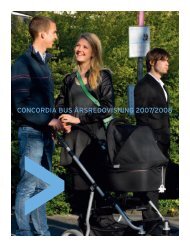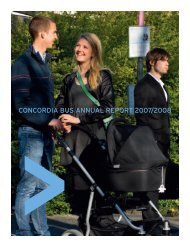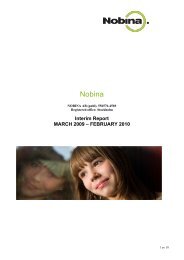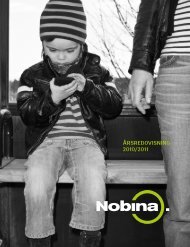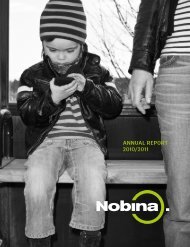Annual Report 2012/2013 5.09 MB - Nobina AB
Annual Report 2012/2013 5.09 MB - Nobina AB
Annual Report 2012/2013 5.09 MB - Nobina AB
- No tags were found...
Create successful ePaper yourself
Turn your PDF publications into a flip-book with our unique Google optimized e-Paper software.
PUBLIC TRANSPORT IN FLUXTRAVEL IN THE NORDIC REGIONIn Sweden, travel by car and public transport are bothincreasing. In <strong>2012</strong>, bus traffic accounted for around 53 %of total public transport. That can be compared with thesubway, which accounted for approximately one-third,and trains for approximately 14 %. However, over the lastten years, bus traffic has not managed to increase itsshare of public transport.The development of Norwegian public transport isbehind that in Sweden and does not meet today’s transportneeds. The railway network is less developed thanin Sweden and with expected population growth of 40%in and around the major cities in the next few years, publictransport is under considerable pressure. In the nextfew years, large parts of the market are expected to besubject to competition, which opens up many opportunitiesfor <strong>Nobina</strong>. In Norway, bus traffic accounted foraround 60 % of total public transport and its share of themarket has remained the same over the last few years. InFinland, public transport grew in the Helsinki area andbus traffic accounted for slightly more than half of alltrips.In Denmark, the number of passengers has decreasedsince 2003, which is explained by economic growth andheightened competition from cars as the primary modeof transportation. In a similar pattern, the number of bustrips increased by 2.4% in 2010 due to the financial crisis.Over the last two years, comprehensive changes havebeen made to public transport in the form of cutbacks,structural changes and streamlining of both city andregional traffic. The fall of 2011 saw a shift in governmentin Denmark and a number of initiatives could affect theconditions for conducting public transport operations.For instance, the new government is expected to promotepublic transport, chiefly by means of lower ticket prices.operation, but they will be replaced by tendered contracts over thenext few years.Denmark is somewhat of a pioneer when it comes to the deregulationof public transport, with all of its traffic tendered. Theregional bus markets in Norway and Finland are also expandingbecause more and more contracts are being competitively procured.This means that, despite the differences in legislation and collectiveagreements, the same business model can be applied throughoutthe Nordic region.New EU legislation is moving in the direction of continuedderegulation, holding up the Nordic model as an example.In <strong>2012</strong>, the majority of international traffic companies had lowor negative profitability in their Nordic operations. Three of thefour major bus companies in Sweden suffered losses in <strong>2012</strong>.INCREASED FOCUS ON INCENTIVES AND VALUEThe trend throughout the Nordic region is toward more incentivedrivencontracts, which will increase travel and make it profitableto offer public transport services. In these types of contracts, trafficcompanies are given more freedom in designing traffic solutions.They also obtain a higher share of the variable revenue, since thenumber of passengers and various types of quality measures areweighted in the compensation models. As more and more trafficareas open up for competition, prices are expected to improve andfavour the traffic companies that can deliver good quality at a goodprice. It puts the focus on traffic companies that deliver the promisedlevel of quality.80 % of the tendering carried out in Sweden in <strong>2012</strong> included apassenger incentive share of at least 25%. 44 % of the PTAs followedthe industry’s standardization recommendations for vehicles (Buss2010) without making their own additions. 19 % only have functionalenvironmental requirements. 62 % follow the indexationrecommendations. In 70 % of the tendering, responsibility for localmarketing is delegated to the traffic company. In 72 % of the tendering,the traffic company is responsible for the planning of timetables.In 80 % of the tendering, traffic planning was delegated tothe traffic companies (Source: Bus industry statistics <strong>2012</strong>).PUBLIC TRANSPORT IS COSTLY, BUT THE OVERALLCALCULATION IS FAVOUR<strong>AB</strong>LEIn 2011, the direct costs for local and regional public transportamounted to approximately SEK 34 billion. Since 2000, the directcosts have increased by 80 %, but the direct revenue has onlyincreased by 50 %. In 2011, revenue from operations was SEK 16 billionand the rest was financed through grants and public contributions.71 % of the grants were from the county councils, 28 % wasfrom municipalities and 1 % was government funded. Since 2000,the grants from municipalities and county councils have more thandoubled. In 2011, costs increased by 18 % but revenue from operationsonly increased by 13 %. Tax subsidies for public transportamount to SEK 1,741 per resident each year for the whole of Sweden.When times are tough, it is difficult for the government, municipalitiesand county councils to achieve a balanced budget, whichmakes it more difficult for public transport to receive higher appropriations.The economic climate also affects the funding of buses,which accounts for around 40 % of the costs in contracts. All buses21



